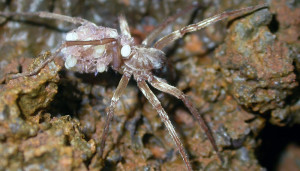When I started looking into spider conservation, I wasn’t sure how much information I would find, but I assumed that there was a growing body of literature. And that is accurate, although I was surprised to see how much of it was about the impact of land management practices on spider communities in general. There are definitely endangered spiders and also some very specific studies on spider ecology, but many of the papers I found looked at agricultural practices or fragmentation and how specific spider populations responded (often wolf spiders- it would appear that wolf spiders are very popular).
I’ll get to some of that research in a moment, but I want to start with a quick glance at the general health of spider species: a look through the CITES appendices shows that 22 species, all of them tarantulas, are listed in Appendix II (for a refresher on CITES, check out my post from April 2013)- this seems to be connected to their popularity in the exotic pet trade; when I visited the IUCN Red List site, I counted 13 Vulnerable, 1 Near Threatened, 5 Endangered, and 7 Critically Endangered spider species– several genera [including Paraheliophanus (jumping spiders) and Poecilotheria (Indian and Sri Lankan tarantulas)] had multiple species listed, so it seems like certain groups are particularly at risk. Included among the vulnerable species is the Lake Placid funnel wolf spider- since many of the species I’ve mentioned already are tropical species, it’s important to note that temperate species possibly found in our backyards are at risk, too.

A Kauai cave wolf spider transporting young- these cave dwellers have lost their eyes. Photo by Wendy Kashida/USFWS
What factors make certain species or groups of species vulnerable? As has been mentioned so many times before in this blog, habitat loss and fragmentation are big issues– a 1995 review of spider conservation in Australia found that land management practices and habitat loss were the main concerns (Yen 1995). The same is true in locations around the world. A study in Arizona found that, while spider abundance increased in agricultural areas and yards (think of all that extra water…), spider diversity was greatest in the original desert areas (Shocat et al. 2004). Regular plowing of agricultural fields lowers spider diversity, too (Haskins and Shaddy 1986). Uetz (1991) suggested that spiders are particularly sensitive to changes in soil and vegetative structure because they use vibrations to locate prey and often need specific conditions for web construction. Certain species are also vulnerable to habitat fragmentation because they move within very small areas- for example, Eresus spiders tend to create burrows close to their mother’s web (Krause et al. 2011).
Some spider species are also in precarious positions because they are found across a very small range. Ysnel et al. (2008) found that in Europe endemic species were concentrated along the Mediterranean and in caves- indeed, the smallest spider in Europe is endemic to a cave in the Iberian Peninsula (Cardoso 2008). Caves in general are important locations for spiders with small ranges- there’s the Kuaui cave wolf spider in Hawaii (also known as the no-eyed big-eyed wolf spider…), the Kanthan cave trapdoor spider in Malaysia, and the Dolloff cave spider in California and Texas, just to name a few.
And I think it’s important to include generally negative public attitudes which don’t place a lot of importance on monitoring and protecting spider populations. Kellert’s (1993) research on perceptions of invertebrates found that spiders in particular generated a lot of fear and dislike from the public. As a result, most respondents said they would not support major efforts to protect endangered spiders (they also said the same for molluscs…).
So, if there are a variety of black marks against spider conservation, do we at least have some ways to move forward, too? In my next post, I’ll look at what we’re learning about the best ways to protect spider species in danger.
Works cited:
Cardoso P. 2008. Biodiversity and conservation of Iberian spiders: past, present and future. Boletin Soc. Entomol. Aragon. 42:487–492.
Haskins MF, Shaddy JH. 1986. The ecological effects of burning, mowing and plowing on ground-inhabiting spiders (Araneae) in an old-field system. J. Arachnol. 14:1–13.
Kellert SR. 1993. Values and perceptions of invertebrates. Conserv. Biol. 7:845–855.
Krause RH, Buse J, Matern A, Schroder B, Hardtle W, Assmann T. 2011. Eresus kollari (Araneae: Eresidae) calls for heathland management. J. Arachnol. 39:384–392.
Shocat E, Stefanov WL, Whitehouse MEA, Faeth SH. 2004. Urbanization and spider diversity: influences of human modification of habitat structure and productivity. Ecol. Appl. 14:268–280.
Uetz GW. 1991. Habitat structure and spider foraging. In: Bell SS, McCoy ED, Mushinsky HR, editors. Habitat Structure: The Physical Arrangement of Objects in Space. London, UK: Chapman & Hall. pp. 325–348.
Yen AL. 1995. Australian spiders: an opportunity for conservation. Rec. West. Aust. Mus. 52:39–47.
Ysnel F, Petillon J, Gerard E, Canard A. 2008. Assessing the conservation value of the spider fauna across the west palearctic area. J. Arachnol. 36:457–463.
